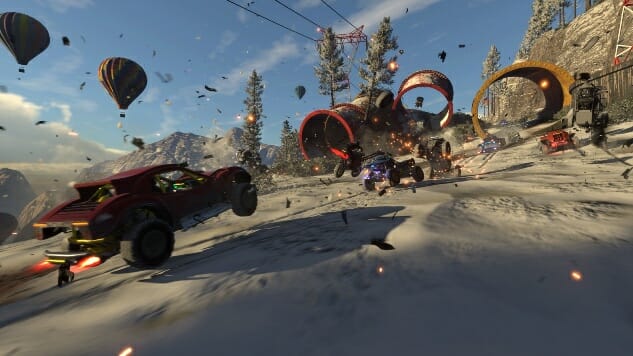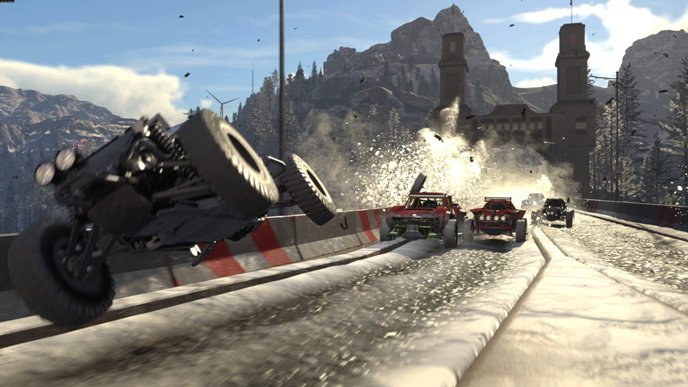
Enter Mad Max: Fury Road—two hours of cinema in constant motion, a convoy kicking up dust and leaving churned metal in its wake. It offers a visual catharsis—albeit a violent one—of a world where the destination is merely a backdrop and the starting point is deep in the past. What matters most is what happens between beginning and end, cars weaving between and slamming into one another. It’s loud, brash and unabashedly obsessed with the madness of speed. Now, enter Overwatch—a hero based first-person shooter that urges teamwork over a lone wolf mentality. Balancing classes, looking out for your team, and playing the objective are what matter most. Death racing across a barren wasteland can be team based as well, with war boy looking out for war boy. Codemasters has found the common ground between a death race and a team-based shooter, between Fury Road and Overwatch, in their newest game Onrush.
Onrush is an arcade racing game with no beginning and no finish line—in the classical sense. It melds arcade racing with the template of play found in the common, modern online-shooter. In theory, this idea probably shouldn’t work.And yet Codemasters has brought something truly original to the racing genre.
A racing game where finishing first isn’t the point might sound preposterous, but Onrush is a refreshing take on arcade racing and online competition. The feeling of triumph and the rush of adrenaline felt when you just barely snake into first place during a sprint race in Forza Horizon 3 is one of the best and rawest feelings that games can elicit. As a form, videogames are meant to be beaten and, like a race, that usually involves the player besting a series of challenges—usually ever increasing. Onrush trades in the first-place mentality for the triumph-through-teamwork and objective completion nature of most modern shooters. The result is a game that feels both unique and completely of our current moment.
Onrush’s core conceit is a six player vs. six player multiplayer experience where two teams thrash metal and boost past one another in order to complete different types of objectives in a series of interesting modes. Each vehicle, chosen before each match and after every crash, has its own unique class-name and a certain special move—team buffs, a timed damage boost and so on. They all handle differently enough to feel new when put to use. Some vehicles are meant for action, taking out rival players, while others are more defensive in that, when used correctly, they will help shield teammates from taking damage or supply them with extra boost.
Boost acts as a core pillar to Onrush’s player locomotion. Getting air and taking out rival players or any of the constantly respawning AI vehicles that litter the track will add to every car’s boost meter. Boost enough and the car’s special move will be available to use. It is in this core loop that Onrush begs the player to go fast, take the offensive and take every risk possible. A big jump? Go for it. A pack of cars ahead? Power through them, leaving a smoldering graveyard of crushed bumpers and chassis in your wake. Speed is your best friend in Onrush and, when boost is used tactically, it becomes the key to completing most of the motion-based objectives. For example, one of the game modes, Lockdown, is a domination-like mode where a circle that is always ahead of the stampede of vehicles becomes the focal point for in-game conflict. Using boost and each car’s special move offers the chance to get to the contested spot of land before the rival team can. When a team times and uses their boost and specials consecutively, holding the objective becomes an easy victory over the enemy team. Like boost, teamwork is greatly pressed onto the player.
Every multiplayer mode and the hero-type vehicle layout in Onrush begs players to work together. In my time with multiplayer, teams that worked together and balanced out their vehicular class-types always reigned victorious over the other team. Granted, as of now, ranked play is locked—using teamwork in the quickplay section of multiplayer is still relatively easy. Speaking of ease, the game’s arcade racing and beautifully colorful visuals hides a deceptively high skill-ceiling. In this, Onrush becomes comparable to Rocket League. Upon the latter game’s launch, tactics and high-skill play had yet to exist and most players competed at a similar skill-level. In its current state, the same can be said for Onrush—enough time has yet to pass for players to really dive into specific handling tricks and communication skills to create a higher, pro-like level of play. Yet, every facet of the game suggests that, given time, its simplicity and arcade-like kindness will yield a more creative and deeply-tactical experience. Through the eventual addition of ranked play, this will likely become readily apparent. The ranked play is currently locked away and will be arriving at a later date, and I look forward to what its addition will bring to the games community.

For Onrush to have legs post-release, it needs to unveil a certain sense of complexity and competition, and the game wants to become the next big thing for streamers. At the end of the day, it is fun—fun that has been play tested and distilled into a constant loop of joy that forever remains in forward-motion. Its player feedback loop adds to the constant sense of forward-motion because, somehow, you are always earning experience points or loot boxes. Finishing in first place is not the point, so you’ll earn XP in various ways, from knocking enemy players out, to simply using in-game gestures to congratulate a teammate for their help in completing an objective.
The rewards for leveling up come in a few forms. Earning Call of Duty-like clan-tags is one of the most constant rewards and the other is loot boxes. No gameplay mechanics or player boosts are hidden in the loot boxes and, in the wake of the shitstorm that Star Wars Battlefront 2’s loot box implementation caused, that is assuredly for the better. Yet, players can still spend real money to buy said loot boxes, and that still feeds into the gambling-like feedback that loot boxes, as a randomized system, harkens to. Loot boxes are unilaterally a moot point—they are bad, through and through. That being said, Onrush has, for my money, the best loot box opening animation in videogames. A car smashes into a robotic loot box in a quick act of zealous, excitable carnage and then the box’s contents are granted to the player. The act of acquiring more in-game currency and loot boxes tends to act as one of the more blatant player-feedback loops in the game.
Onrush, while primarily a multiplayer focused experience, offers a rather lengthy single-player (also playable in couch/online co-op) mode. It is laid out in a series of unlockable events—each event containing a certain number of races—that acts as a glorified tutorial mode for the vehicles and multiplayer modes. As such the single-player experience quickly falls into repetition. It doesn’t become truly mind numbing, though, because each event has a certain number of ever-changing challenges that, when complete, rewards the player with points that help to unlock the next single-player event. It is these Star Fox 64-like challenges that kept me coming back to the game’s single-player mode and I was happy with just how lengthy it turned out to be.
As an overall package, Onrush only shows signs of denting and wear and tear in the game’s soundtrack and overall aesthetic. While gorgeous, the game’s visual appeal falls into the same class of futuristic gloss that drapes both Rocket League and Trials Fusion. The visual sterility of the game’s tracks and vehicles, while varied in landscape and vehicle type, began to wear on me the more that I played it. I wish that Codemasters had opted for a more original aesthetic rather than going for the “future-racing greatest hits” veneer that the game currently wears. What got under my skin the most is Onrush’s overly glossy techno soundtrack; musical appeal is very subjective, but Onrush’s soundscape left me reaching for the mute button as soon as I hopped into the game. Though the game’s music is informed by and further informs the game’s visual aesthetic, it just started as annoying and only became even more so with each hour that passed.
Given Onrush’s convoy-based action, I couldn’t help but daydream of playing it while C.W. McCall’s “Convoy” twanged out of my TV’s speakers. Thanks to the Spotify app on Xbox One, this dream became a reality and my already gleeful smile grew ten-fold as I, for the hundredth time, found myself at the beck and call of Onrush’s adrenaline-laced excitement. Onrush is an experience that knows exactly what it is. It does not try to be more than a fresh take on the arcade racer, and in deftly juggling between joyous simplicity and skill-based complexity Onrush has quickly become one of my favorite games in recent memory. Just make sure you listen to anything but the game’s soundtrack while you speed-boost your way through Onrush’s all-too-familiar visual beauty.
Onrush was developed by Codemasters and published by Deep Silver. Our review is based on the Xbox One version. It is also available for PlayStation 4.
Cole Henry is an intern with Paste. He’s on Twitter @colehenry19.